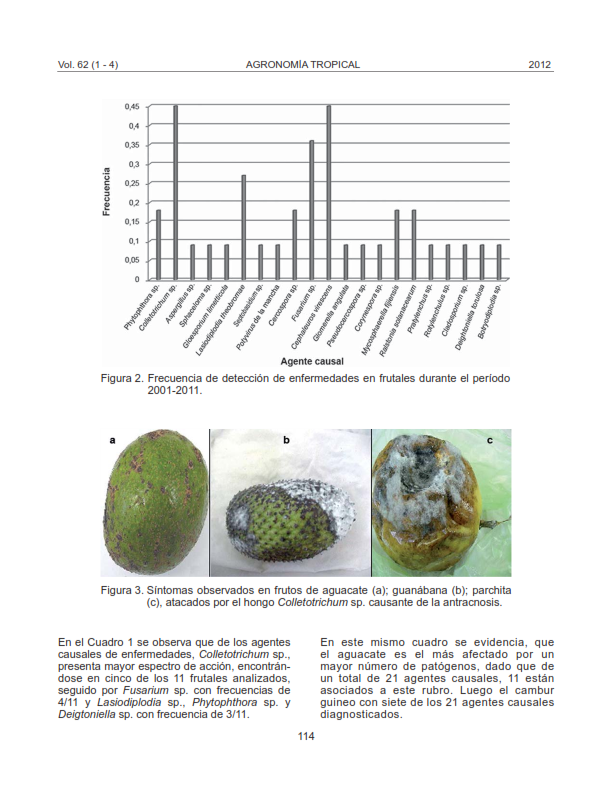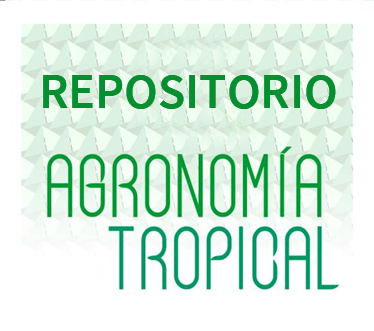Diagnosis of diseases in fruit in Yaracuy state, Venezuela between the years 2001-2011
Abstract
One of the main constraints in fruit production systems in Venezuela is the presence of disease, and Yaracuy state is no exception. This work aims to raise awareness of the disease diagnosed by INIA- Yaracuy in priority fruits of the state, between the years
2001-2011. Samples were received from farmers; the evidence is recorded using the qualitative approach of action research. Direct observation of symptoms and fungal structures and bacterial slime is then performed as appropriate to the optical microscope at 10X and 40X. Samples were washed twice with water, twice with 70% ethanol and twice with distilled water, then placing in a humid chamber for 48 to
72 hours; then isolates and reisolation were performed in Petri capsules contents culture medium Potato Dextrose Agar (PDA) for fungi and Nutrient Agar (NA) and selective medium for bacteria on TZC laminar flow chamber; were placed at 27 °C, continuous white light or darkness for 48 to 72 hours and the colonies obtained were characterized and inoculations. Finally, identification was performed by standard taxonomic keys and literature. The avocado figure represented 55% of the samples, followed by coffee and orange, with 8% each. The pathogenic fungus Colletotrichum sp. was detected in 45% of samples; mostly from the municipality Aristides Bastidas (33.33%).
Downloads
References
• Alexopoulos C., J., C. W. Mimns and M. B.Blackwell. 1996. Introductory Mycology: Phylum Ascomycota. Fourth Edition. Toronto and Singapore, John Wiley & Sons, INC. New York, Chicheter, Brisbane. pp. 180-486.
• Almodóvar, W. y M. Díaz. 2001. Enfermedades de plátano y guineo. Universidad de Puerto Rico- Recinto de Mayagüez, Colegio de Ciencias Agrícolas-Servicio de Extensión Agrícola.13 p.
• Aponte, A., E. Debrot, E. Arnal, R. Solórzano y F. Ramos. 2005. Diagnóstico de las enferme- dades del tomate de árbol en los estados Aragua y Miranda, Venezuela. Revista Digital CENIAP HOY, Número 9, septiembre-diciembre 2005. Maracay, Aragua, Venezuela. Disponible en línea: https://bit.ly/2x856Va. [Consulta: 2013, julio 01].
• Barnett, H. L. and B. B. Hunter. 1972. Illustrated genera of imperfect fungi. Third Edition. Burgess Publishing Company Minneapolis, Minnessota (EEUU). 241 p.
• Blanco, G., J. B. Hernández, G. Martínez, A. Ordosgoitti, A. Pérez y E. Manzanilla.
• 2004. Prácticas sostenibles de manejo en el cultivo del plátano (Musa AAB) adaptadas a las condiciones agroecológicas del estado Yaracuy. Editado en INIA-CIAE Yaracuy, San Felipe, estado Yaracuy. Ministerio de Ciencia y Tecnología (MCT), Dirección General de Coordinación de Programas, Caracas. 16 p.
• Bacteriology Committee of American Phytopatho- logical Society. 1989. Laboratory Guide for identification of plant pathogenic bacteria. Ed. Schaad, N. W. Georgia, EEUU. Department of Plant Pathology, University of Georgia (EEUU). 69 p.
• FEDEAGRO. 2013. Estadísticas Agropecuarias. Producción Agrícola. Indicadores de la Producción por Grupo de Cultivo: Sub Sector Agrícola Vegetal. Memoria y Cuenta Ministerio de Agricultura y Tierras 2010-2012. Disponible en línea: https://bit.ly/2J61Kod [Consulta: 2013, marzo 30].
• Flores, E., M. Maffei, B. Camacho y A.Quintero.2010. La muerte regresiva de las cítricas enTrujillo. INIA Divulga N° 15. pp. 31-32.
• FONTAGRO, 2006. Fortalecimiento de cadenas de valor de plátano: Innovaciones tecnológicas para reducir agroquímicos. FONTAGRO, CIAT, INIA, INIAP, ESP.OL, CIRAD, ECOFLORA, Galería, Universidad de Caldas, CORPOICA, SANOPLANT. Colombia. 49 p.
• Hernández F., J. B. 2008. Influencia de la fertilización, las malezas y programas de manejo de Sigatoka negra Mycosphaerella fijiensis Morelet en ‘Plátano Hartón’ en el municipio Veroes, estado Yaracuy, Venezuela. Tesis Doct. Universidad Central de Venezuela. 315 p.
• Hernández, F., J. B., A. Pérez, R. Ortega, E.Medina, L. Hernández, J. Morillo y G. Blanco. 2010. Evaluación del efecto de dos lixiviados de ‘Plátano Hartón’ (Musa AAB) en el control de la Sigatoka negra (Mycosphaerella fijiensis Morelet) en el municipio Veroes del estado Yaracuy. Memorias XI Congreso Venezolano de Fruticultura. Coro. (Resumen, Formato CD).
• Hernández, J., R. Ortega y G. Blanco. Diagnóstico fitosanitario Yaracuy. 2011. Memorias XXII Congreso de Fitopatología. SVF, INIA, Universidad de Los Andes, Central La Pastora, Fundación DANAC. Del 8 al 11 de noviembre. Trujillo, estado Trujillo90. (Resumen, Formato CD).
• Hernández S., R., C. Fernández-Collado y P. Baptista. 2006. Metodología de la investigación: El proceso de la investigación cualitativa. Tercera Parte. Mc Graw Hill Interamericana. Cuarta. (México). ISBN-13: 978-970-10-5753. pp. 521-805.
• Martínez, B. R. y N. L. Estrada. 1994. Importancia de la antracnosis Colletotrichum gloesporoides y la roña Sphaceloma persea en la producción de aguacate en Michoacán. Facultad de Agrobiología U.M.S.N.H. documento inédito. 8 p.
• Ministerio del poder popular para la Agricultura y Tierras. 2013. VII Censo Agrícola Nacional (mayo 2007/abril 2008). Disponible en línea: https://bit.ly/3b7Xvoj. [Consulta: 2013, abril 13].
• Navarro, R. y R. Liendo. 2010. Fluctuación poblacional de Scolytidae (Insecta: Coleóptera) en cacao del estado Aragua (Venezuela). Agronomía Trop. 60(3):255-261.
• Rondón, A. 1993. Problemática causada por los hongos del suelo en frutales: Alternativas y control. FONAIAP Divulga, septiembre- diciembre. N° 44. Disponible en línea: https://bit.ly/33xJhuv [Consulta: 2014, abril 01].
• Rondón, A., E. Arnal, E. Soto y R. Solórzano. 1995. El manejo integrado de enfermedades en algunos frutales de ciclo corto. FONAIAP Divulga, abril-junio. N° 48. Disponible en línea: https://bit.ly/3a6T4Ka [Consulta: 2014, abril 01].
• Rosales, F. E. y A. S. Riveros A. 2003. Desarrollo y uso de bioproductos para el control de nemátodos y Sigatoka negra en plantaciones de plátano y banano. Fondo Regional de Tecnología Agropecuaria (FONTAGRO). Costa Rica. 37 p.
• Salgado S., M. L. 1993. Problemas fitosanitarios del aguacate en Coatepec Harinas, Méx. In: Rubi Arriaga Martín (ed). Memoria de actividades de la Fundación Salvador Sánchez Colín CICTAMEX S.C. Coatepec Harinas, México. pp. 191-212.
• Tamayo M., P. J. 2007. Enfermedades del Aguacate. POLITÉCNICA N° 4, mayo – julio Medellín (Colombia). pp. 51-70.





